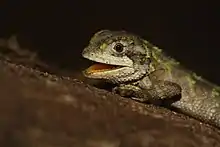Pseudocalotes austeniana
Pseudocalotes austeniana, commonly known as the Abor Hills agama[1] or Annandale's dragon,[2] is a rare species of agamid lizard endemic to Asia.
| Pseudocalotes austeniana | |
|---|---|
 | |
| Scientific classification | |
| Kingdom: | Animalia |
| Phylum: | Chordata |
| Class: | Reptilia |
| Order: | Squamata |
| Suborder: | Iguania |
| Family: | Agamidae |
| Genus: | Pseudocalotes |
| Species: | P. austeniana |
| Binomial name | |
| Pseudocalotes austeniana (Annandale, 1908) | |
| Synonyms | |
| |
Etymology
The specific name, austeniana, is in honor of English topographer Henry Haversham Godwin-Austen.[2]
Geographic range
P. austeniana is found in Bhutan and India (Assam, Arunachal Pradesh).[1]
Type locality: "Hills near Harmatti, Assam"[3] (= Dafla Hills, Assam, fide M.A. Smith 1935).[1]
Rediscovery
This species was previously known only from its holotype, but was rediscovered in 2006 at Eaglenest Wildlife Sanctuary in Arunachal Pradesh.[4]
Notes
- "Pseudocalotes austeniana ". The Reptile Database. www.reptile-database.org.
- Beolens B, Watkins M, Grayson M. 2011. The Eponym Dictionary of Reptiles Baltimore: Johns Hopkins University Press. xiii + 296 pp. ISBN 978-1-4214-0135-5. (Mictopholis austeniana, p. 13).
- Annandale N. 1908. Description of a new Species of Lizard of the Genus Salea from Assam. Rec. Indian Mus. 2: 37-38. (Salea austeniana, new species).
- Athreya R. 2006. Eaglenest Biodiversity Project − I (2003–2006): A report submitted to the Forest Department of the Government of Arunachal Pradesh, India, and the Rufford-Maurice-Laing Foundation (UK). Kaati Trust, Pune. Conservation Resources for Eaglenest wildlife sanctuary, p. 54. Archived 2010-06-02 at the Wayback Machine
Further reading
- Smith MA. 1935. The Fauna of British India, Including Ceylon and Burma. Reptilia and Amphibia. Vol. II.—Sauria. London: Secretary of State for India in Council. (Taylor and Francis, printers). xiii + 440 pp. + Plate I + 2 maps. (Mictopholis, new genus, p. 149; Mictopholis austeniana, new combination, p. 165, Figure 50).
This article is issued from Wikipedia. The text is licensed under Creative Commons - Attribution - Sharealike. Additional terms may apply for the media files.